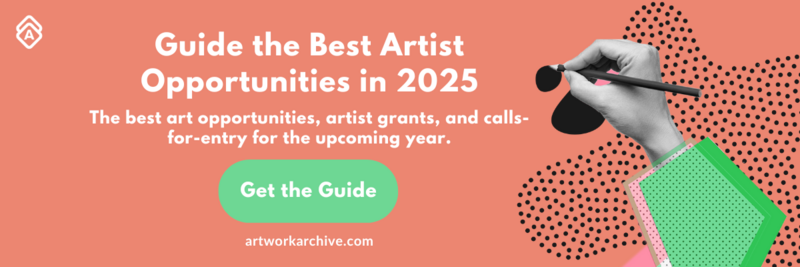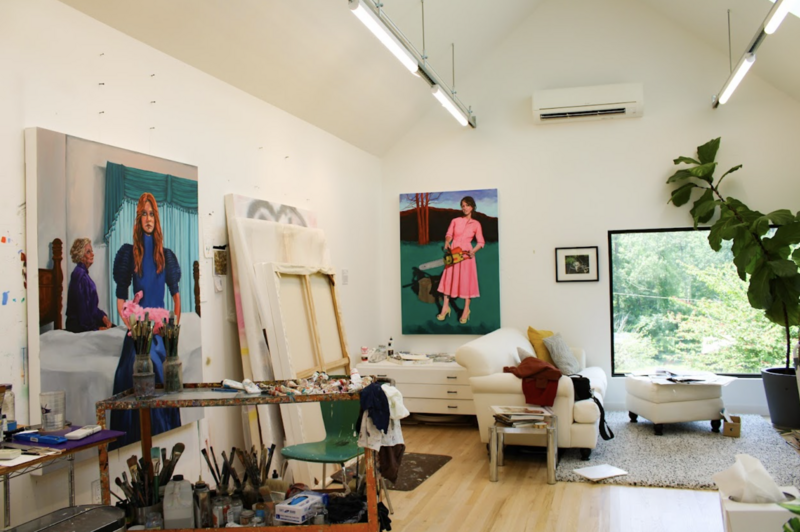
A view from inside Artwork Archive artist Sharon Shapiro's studio
10 Things 2024 Taught Us About Being a Professional Artist
Do you remember the old adage "Do what you love and you'll never work a day in your life"? Yeah, we do too. And, while it's a nice sentiment (and does, we admit, hold a little bit of truth), what they forgot to mention was that running a successful art business means working harder than ever—just with irregular hours, creative freedom, and the satisfaction of building something entirely your own.
While clichéd advice and inspirational quotes have their place in the art world, 2024 brought us some practical insights from real, working artists that are actually worth your time.
Through conversations with artists who’ve built sustainable careers without sacrificing their vision, we uncovered 10 lessons that bridge the gap between making art and building a business:
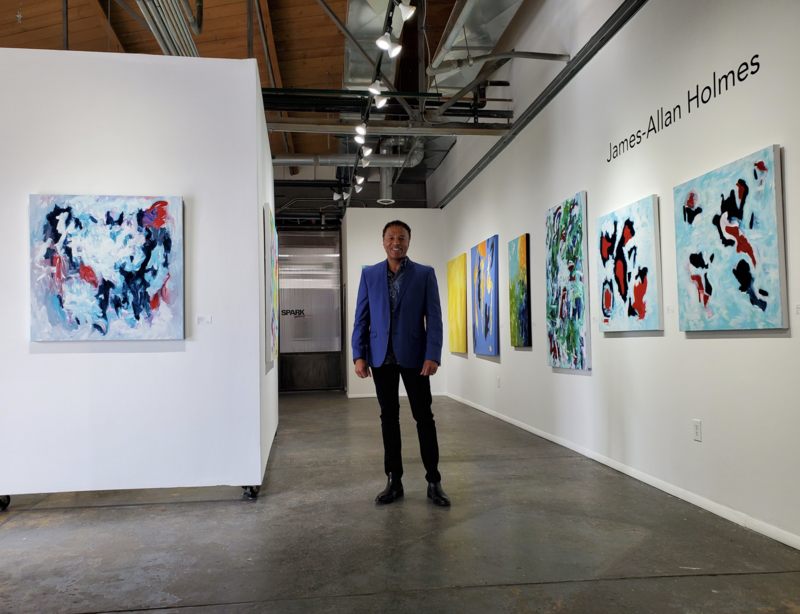
James-Allan Holmes pictured during an exhibition. Image courtesy of the artist
Your Authentic Work Will Find the Right Audience
“Don’t make work for anyone else.
Make work you like and work that you love. Make work that challenges you and is difficult to produce. If you do that, the rest will fall into place.”
—James-Allan Holmes
It's tempting to scroll through Instagram and think "I should paint more like that" or "maybe if I used these colors, my work would sell better." But, abstract artist James-Allan Holmes offers a powerful reminder: art that comes from a genuine place will resonate far more deeply than art created solely to please others.
The pressure to follow trends or appeal to certain audiences can cloud your creative vision, but staying true to your own artistic voice is what sets your work apart.
Your authenticity has its own gravitational pull—it will attract the right collectors, galleries, and opportunities when you make work that matters to you.
Give Yourself Permission to Play
“Don’t ever stop experimenting.
Remind yourself that your job is to follow your curiosities. Cultivate a sense of awe and wonder at what is possible, and let the work reveal itself.”
—Sharon Shapiro
We love how figurative painter Sharon Shapiro puts this: an artist's job—perhaps the most important one—is to follow those odd, persistent sparks of curiosity wherever they may lead. Curiosity, after all, has been the driving force behind some of the most groundbreaking, unexpected, and deeply personal works ever created.
Too many artists get stuck trying to replicate their own success or chase what’s "working" for others. But safe and predictable rarely lead to anything memorable.
So, lean into the unknown. Follow the questions instead of the answers. And if it starts to feel uncomfortable? Good. That discomfort signals growth.

Artist Monique Crépault pictured in her studio. Image courtesy of the artist
Consistency is Key
“You have to be in your studio every day, whether you feel like it or not.
It's the only way to keep doing it."
—Monique Crépault
We've all had those mornings when the studio feels more like a challenge than a sanctuary. The inspiration tank is running on empty, and a Netflix marathon is calling your name. But, as figurative painter Monique Crépault reminds us, "inspiration finds you working."
The magic often happens in those mundane moments when you choose to show up anyway.
Raw talent might spark the journey, but it's the quiet commitment to showing up, day after day, that builds a sustainable art career.
See Rest as Part of the Work
“Even when you’re not actively working, as an artist, you are.
You're developing mentally, emotionally, and creatively, even when you’re at rest. And rest—truly doing nothing—is integral to being an artist.”
—Jilli Darling
Now, this might sound like it contradicts Monique's advice from above about showing up every day—but there's a key difference: consistency does NOT mean pushing yourself to exhaustion. Think of your studio practice like breathing: there's an inhale (active creation) and an exhale (rest and reflection). Both are essential rhythms of the creative process.
The most successful artists schedule rest time as intentionally as their creative work—and treat it as non-negotiable.
So, next time you're feeling guilty about taking a well-deserved break, remember visual artist Jilli Darling's advice: Your art brain is still working, even when you're not holding a brush. And sometimes, the best thing you can do for your art is absolutely nothing at all.
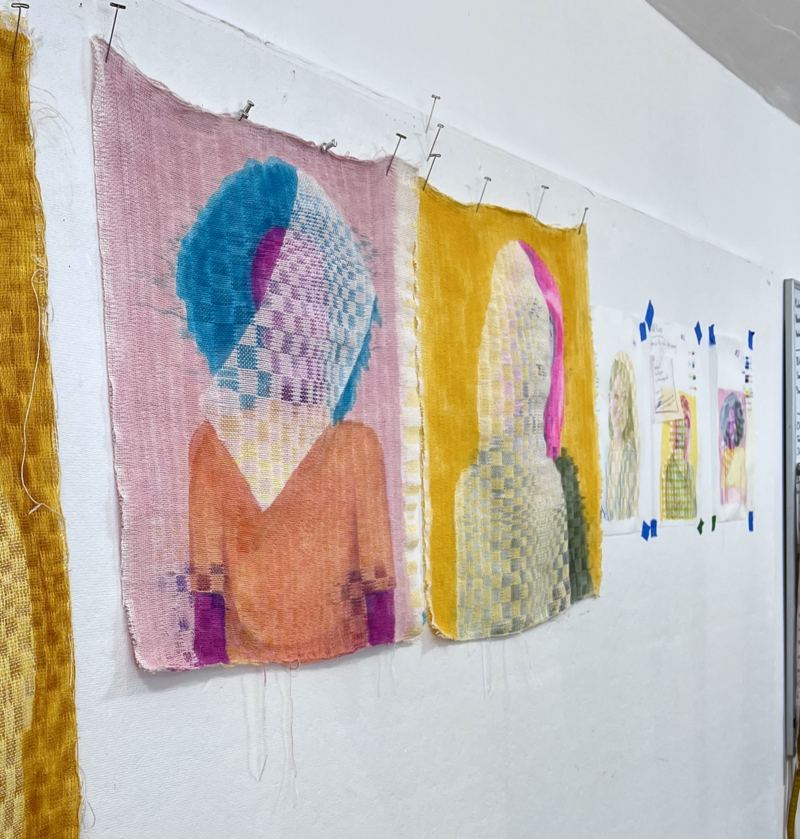
A studio wall view of Melissa English Campbell's studio. Image courtesy of the artist
Art is Half Studio, Half Strategy
“I wish I had better understood the mechanisms of the art market and the importance of what needs to be done outside of the studio to develop my artistic career and establish my reputation.”
—Yvan Genest
It's a hard pill to swallow, but visual artist Yvan Genest highlights a truth many artists learn the hard way: making beautiful art isn't enough. Galleries aren’t knocking down doors, and collectors can’t purchase work they’ve never seen.
Building a sustainable art career means understanding the business side—how to price your work confidently, market it effectively, and position yourself well in the art world (groan...networking).
Carving out time to research grants, explore new opportunities, or sharpen those marketing skills might not feel as satisfying as finishing a piece, but it’s the bridge that connects your art to the rest of the world.
Think of it as being bilingual—switching between creating work in the studio and learning how to get it seen, valued, and collected.
Find Opportunities That Fit Your Art Career:
Skip the endless scrolling and questionable listings. Artwork Archive’s Opportunity Guide is packed with carefully vetted calls and residencies, making it easier to find the ones that truly fit your art career.
Curious what’s out there? Check out our Complete Guide to 2025 Artist Opportunities here.
Think Like an Entrepreneur
“People are surprised to learn how similar being an artist is to being a small business owner.
We both have to market, network, and prospect. We both have to file taxes, do bookkeeping, and maintain professional relationships.”
—Melissa English Campbell
Yvan highlighted the importance of strategy—understanding the art market, pricing confidently, and positioning your work. Visual artist Melissa English Campbell builds on that, focusing on the day-to-day systems and habits that keep things from falling apart when life gets busy.
Her advice? “Set up your ‘back office’ early—this should include archiving images of artwork for quick, easy access, bookkeeping, and putting systems in place to keep the administrative side from becoming overwhelming.”
No one loves archiving files or managing receipts, but having systems in place (ahem, like Artwork Archive) makes life so much easier when opportunities start rolling in. The truth is, the artists who thrive are the ones who plan ahead. Taking a little time now to build strong habits means you’re ready for whatever comes next.
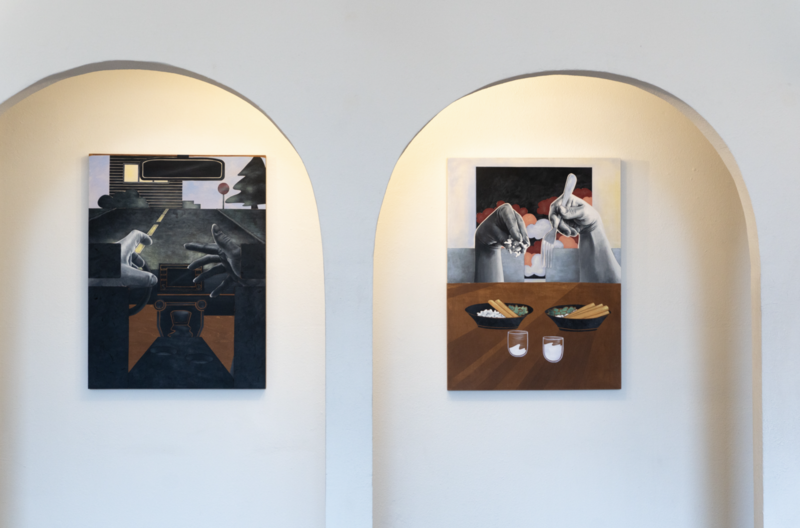
An image from 'Secret Life of a Multicultural Couple' Exhibition by artist April Werle. Image courtesy of the artist
Art Has the Power to Transform Lives
"We have a responsibility as artists to be thoughtful in the work we create. We turn to the arts to learn about what it means to be human.
What you say through your work can have a significant impact on someone’s life.”
—April Werle
Visual artist April Werle reminds us just how powerful art can be. It inspires, challenges, heals, and comforts—it connects people across experiences, cultures, and time. As artists, that’s no small responsibility. The work you create doesn't exist in a vacuum.
“I believe we have a responsibility as artists to be thoughtful in the work we create,” April continues. “Being mindful of who your work impacts most can also help grow your art career.”
Being intentional about your message and mindful of your audience doesn’t mean shaping your work to fit someone else’s expectations. It just means recognizing that your voice as an artist carries weight. Use it well, and it just might reach someone exactly when they need it most.
Trust is Great—Contracts Are Better
“I’ve learned that good communication skills are very important.
If you’re doing a commission, get a contract written up so everyone involved knows what’s expected, and there’s no confusion. The same goes for working with a new gallery.”
—Mark Acetelli
Visual artist Marck Acetelli makes a solid point: contracts are your safety net. Nobody wants to be that artist chasing payments or redoing a commission for the third time because of a "misunderstanding." Yet, these situations pop up all too often when agreements stay verbal.
A written contract that spells out expectations, timelines, payments, and rights keeps things clear and saves a lot of headaches later.
Some artists worry that pulling out a contract might seem cold or untrusting. But actually, contracts also send a powerful message. They show that you take your work seriously and that you expect others to do the same. Collectors, galleries, and clients will feel more confident working with you when everything is clear and agreed upon upfront.
Pro Tip:
Save yourself the stress of searching for contracts later. Store them in the My Docs section of your Artwork Archive account so everything’s organized and ready to go when you need it.
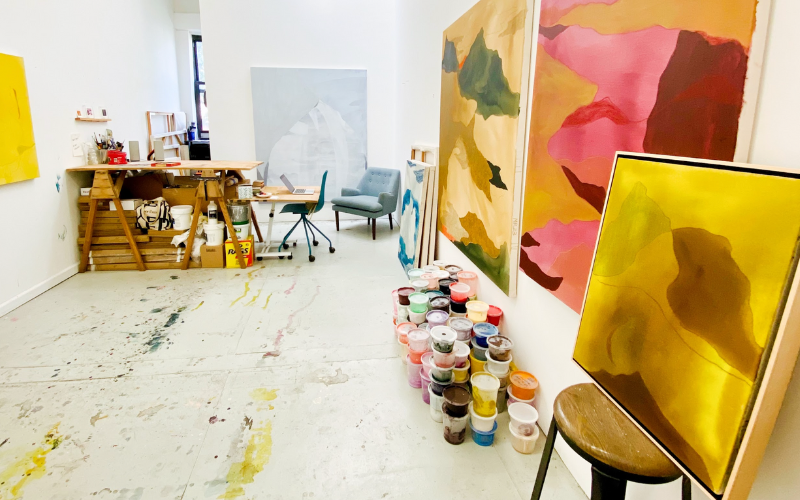
An inside view of artist Mel Reese's studio. Image courtesy of the artist
There is No Right or Wrong Way to Be an Artist
“Do not let preconceived notions of what you think you ‘should’ be doing as an artist stop you from making decisions that are relevant only to you.
Success as an artist is living a life you created versus what others think is best for you."
—Jasmine Best
The “starving artist” trope. The pressure to land gallery shows. The MFA-or-bust mentality. These are all artificial constraints that deserve to be questioned. These ideas have been around for so long that they can feel like unspoken rules—but they’re not. Success in art isn’t a one-size-fits-all formula, and trying to squeeze into someone else’s mold often does more harm than good.
Your path as an artist is yours to define. No one else gets to decide what works for you. It’s easy to get overwhelmed by all the advice out there (yes, even this advice). But not all advice is created equal, and not everything will apply to your path as an artist.
Maybe you thrive in traditional galleries, or maybe you connect better with collectors online. Teaching might fulfill you, or maybe creating art just for yourself is what brings the most meaning. Multimedia artist Jasmine Best says it best: there’s no single right way to do this.
(A Bonus Piece of Advice:)
A Strong System Supports a Thriving Art Career
“I knew I needed a system that would allow me to spend more time on my art.
Artwork Archive helps take away a lot of the nagging, tedious work required to successfully and seamlessly run an art business and grow my career.”
—Mel Reese
We’ve already touched on how the business side of being an artist can eat into your precious studio time—especially if you don’t have the right systems in place. “In hindsight, I wish I had known just how much business savvy you need, and how much time is spent on that part of your career rather than on creating the work itself,” observational painter Mel Reese admits.
But there's good news: you don't have to figure it all out alone. Take it from Mel: "I joined Artwork Archive and have never looked back. I could not be happier with it." Implementing systems—whether for inventory management, invoicing, or tracking opportunities—reduces the likelihood of burnout and helps you stay organized.
